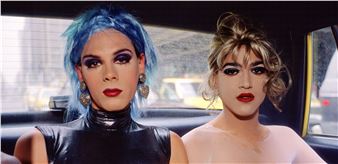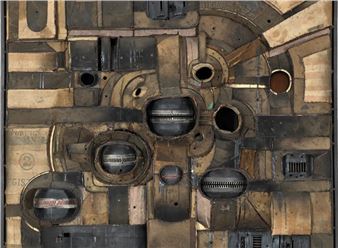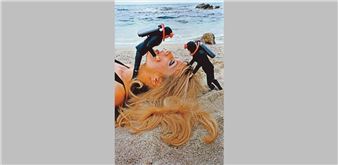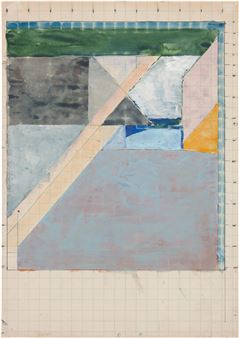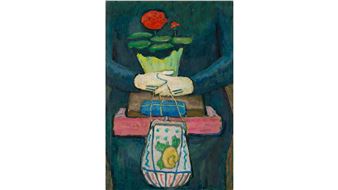Robert Mapplethorpe: Self Portraits
Skarstedt Gallery is pleased to announce the exhibition Robert Mapplethorpe Self Portraits, featuring eleven photographs that illustrate the artistвҖҷs long-term fascination with the genre. As variously costumed characters, Mapplethorpe researches his own identity, capturing his complex and contradictory nature. Whether depicting himself in a playful, fierce, or vulnerable state, the artistвҖҷs explorations are intensely personal and self-reflexive.
In a number of early self-portraits, Mapplethorpe boldly explores the notion of gender. In one work from 1980, the artist appears as a sneering, smoking greaser вҖ“ a James Dean archetype. In another from the same year, Self Portrait (with make-up), Mapplethorpe blurs his gender identity by appearing in partial drag, his face dramatically made-up. By employing conventional signs for man and woman - physical, cosmetic, and sartorial - Mapplethorpe questions established notions of "male" and "female.вҖқ This gender-bending game is once again played in a third self-portrait from 1980. Wrapped in a fur collar, MapplethorpeвҖҷs striking profile makes direct reference to DuchampвҖҷs female alter-ego, Rrose SГ©lavy. In his homage to Duchamp, Mapplethorpe is showing his keen awareness of historical precedents and influences.
Mapplethorpe also uses self-portraiture to explore more serious themes, including his problematized relationship with religion. In a work from 1983, based on the famous 1974 photograph of the newspaper heiress, Patty Hearst, holding a rifle with the symbol of the Symbionese Liberation Army behind her, Mapplethorpe shows himself in battle dress (leather jacket), posing, rifle in hand, in front of an inverted five-pointed star or pentagram, a sign of the Devil. In this work, Mapplethorpe is an aggressor, a rebel soldier fighting for his вҖҳsinfulвҖҷ behavior.
In the later photograph, Self Portrait (with horns), 1985, Mapplethorpe once again casts himself in an evil Satanic role. Yet, through his skillful mastery of black and white photography, in this case employing platinum printing to produce lush, rich tones, the artistвҖҷs evil persona seduces the viewer. This notion is only continued through to a dualism created because of the varied symbolism of horns. Mapplethorpe could also be seen to be playing the role of Dionysus, a Greek god associated with hedonism and sexual desire.
It was not until after his diagnosis with AIDS in 1986 that Mapplethorpe vulnerably reveals himself in his portraits. Taken only months before his passing, for Self Portrait (with cane), the artist is no longer playing a role. Mapplethorpe faces the camera directly, as if he were looking death in the face. The skull-headed cane that he holds in his right hand acts as a memento mori, foreshadowing his inevitable fate. Mapplethorpe is wearing black, so that his head floats free, disembodied, as if he were already halfway to death.
Finally, Skull Walking Cane depicts only the skull from the late self-portrait. A modern day vanitas image, this work suggests the powerful connection between art and life, as well as Mapplethorpe's own transitory existence.

Recommended for you
Skarstedt Gallery is pleased to announce the exhibition Robert Mapplethorpe Self Portraits, featuring eleven photographs that illustrate the artistвҖҷs long-term fascination with the genre. As variously costumed characters, Mapplethorpe researches his own identity, capturing his complex and contradictory nature. Whether depicting himself in a playful, fierce, or vulnerable state, the artistвҖҷs explorations are intensely personal and self-reflexive.
In a number of early self-portraits, Mapplethorpe boldly explores the notion of gender. In one work from 1980, the artist appears as a sneering, smoking greaser вҖ“ a James Dean archetype. In another from the same year, Self Portrait (with make-up), Mapplethorpe blurs his gender identity by appearing in partial drag, his face dramatically made-up. By employing conventional signs for man and woman - physical, cosmetic, and sartorial - Mapplethorpe questions established notions of "male" and "female.вҖқ This gender-bending game is once again played in a third self-portrait from 1980. Wrapped in a fur collar, MapplethorpeвҖҷs striking profile makes direct reference to DuchampвҖҷs female alter-ego, Rrose SГ©lavy. In his homage to Duchamp, Mapplethorpe is showing his keen awareness of historical precedents and influences.
Mapplethorpe also uses self-portraiture to explore more serious themes, including his problematized relationship with religion. In a work from 1983, based on the famous 1974 photograph of the newspaper heiress, Patty Hearst, holding a rifle with the symbol of the Symbionese Liberation Army behind her, Mapplethorpe shows himself in battle dress (leather jacket), posing, rifle in hand, in front of an inverted five-pointed star or pentagram, a sign of the Devil. In this work, Mapplethorpe is an aggressor, a rebel soldier fighting for his вҖҳsinfulвҖҷ behavior.
In the later photograph, Self Portrait (with horns), 1985, Mapplethorpe once again casts himself in an evil Satanic role. Yet, through his skillful mastery of black and white photography, in this case employing platinum printing to produce lush, rich tones, the artistвҖҷs evil persona seduces the viewer. This notion is only continued through to a dualism created because of the varied symbolism of horns. Mapplethorpe could also be seen to be playing the role of Dionysus, a Greek god associated with hedonism and sexual desire.
It was not until after his diagnosis with AIDS in 1986 that Mapplethorpe vulnerably reveals himself in his portraits. Taken only months before his passing, for Self Portrait (with cane), the artist is no longer playing a role. Mapplethorpe faces the camera directly, as if he were looking death in the face. The skull-headed cane that he holds in his right hand acts as a memento mori, foreshadowing his inevitable fate. Mapplethorpe is wearing black, so that his head floats free, disembodied, as if he were already halfway to death.
Finally, Skull Walking Cane depicts only the skull from the late self-portrait. A modern day vanitas image, this work suggests the powerful connection between art and life, as well as Mapplethorpe's own transitory existence.
Artists on show
Contact details


 ARTISTS
ARTISTS







